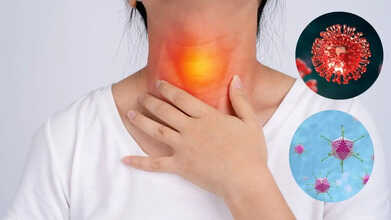- Health Conditions A-Z
- Health & Wellness
- Nutrition
- Fitness
- Health News
- Ayurveda
- Videos
- Medicine A-Z
- Parenting
Is Navel Discharge Normal? Weird Things That Can Leak from Your Belly Button

Belly Button (Credit: Canva)
The belly button marks the exact spot where your umbilical cord was once attached—the vital connection that provided oxygen and nutrients in the womb. Once you started breathing, eating, and discharging waste on your own, this cord was no longer needed. What remains is a mark, a reminder of your months in your mother’s womb. However, it often gets ignored as you grow up. And there is nothing wrong with that. Your belly button does not require a special skincare routine, but neglecting its hygiene can lead to a buildup of bacteria, potentially causing a smelly discharge.
But generally, a discharge from your belly button is normal and colourless. According to experts, normal discharge is typically clear or light-coloured, has a slight odor (similar to sweat), and has no pain or redness around the navel.
What happens when you get a Bacterial or yeast infection in the belly button?
Experts say that the most common funk you might encounter in your belly button is a bacterial or fungal infection. A study titled
A Jungle in There: Bacteria in Belly Buttons are Highly Diverse, but Predictable published in 2012 in PLOS One Journal states that once rarefied to four hundred reads per sample, bacterial communities from belly buttons proved to be at least as diverse as communities known from other skin studies (on average 67 bacterial phylotypes per belly button).
This occurs due to poor hygiene, excessive sweating, or trapped moisture. Other conditions include navel piercings, cysts, and skin conditions like eczema or psoriasis. People with diabetes are particularly susceptible to fungal infections such as candidiasis if their blood sugar isn't under control, according to a 2019 review in the Journal of Clinical Medicine.
Bacteria and fungi love the dark environment of your belly button. If your belly button is infected, you might notice some redness or swelling. The discharge might look like pus, making your belly button smell bad. If it's a yeast infection, your belly button might also itch.
What happens when your navel piercing gets wrong?
Belly button or naval piercing, if infected, can lead to severe pain, discolouration, swelling, discharge and pus. It can also cause the skin to appear red, causing delayed or failed healing.
Other common signs include:
Chills or fever
Persistent pain or inflammation
Sensitivity or discomfort when moving
Swelling or tenderness to touch
When Should You See A Doctor?
You should see a doctor if symptoms persist after several days if you have diabetes or a weakened immune system, if experiencing pain and fever, or if you suspect you have a navel piercing infection. Your doctor might suggest an over-the-counter antifungal cream if it's a fungal infection, but you might need a prescription antibiotic if it's a bacterial infection.How To Cure Hangover Headache At Home?

Credits: Canva
Hangover headaches are miserable. Most people know that drinking too much alcohol can leave you with a long list of next-day problems, and a headache is one of the most common. You will find no shortage of so-called hangover headache “fixes” online, in home remedies, and even on store shelves. The problem is that very few of them are backed by solid scientific evidence. The surest way to prevent a hangover headache is to watch how much alcohol you drink at one time. That said, there are a few simple, home-based steps that may lower your risk of waking up with a headache, and some practical ways to manage the pain if it has already set in.
What Is A Hangover?
A hangover refers to the uncomfortable physical and mental effects you experience after drinking too much alcohol the night before. According to the Cleveland Clinic, hangovers are extremely common among people who overdrink. One study found that nearly 75% of people who consumed excessive alcohol reported hangover symptoms the following day. The same research suggested that about 25% to 30% of drinkers may not experience hangovers at all.
How Much Alcohol Does It Take To Get A Hangover?
Drinking more than one alcoholic beverage per hour can lead to a hangover. Your body generally needs about an hour to break down and process a single drink. As explained by the Cleveland Clinic, one drink is roughly equal to:
- One 12-ounce can of regular or light beer (5% alcohol).
- Half a pint, or about 8 to 9 ounces, of malt liquor or many craft beers (7% alcohol).
- One 5-ounce glass of table wine (12% alcohol).
- One shot, or 1.5 ounces, of liquor (40% alcohol).
How To Cure Hangover Headache At Home?
Many products and home remedies claim they can cure a hangover, but most are not supported by science, and some may even do harm. For instance, having more alcohol the next morning does not fix a hangover. It simply adds more toxins to your system.
Instead, consider these self-care measures for hangover relief:
- Eat simple foods with complex carbohydrates, such as toast or crackers. These can help raise low blood sugar levels and ease nausea.
- Drink plenty of fluids. Water, electrolyte drinks like Gatorade® or Pedialyte®, broth, and other non-alcoholic beverages can help counter dehydration. A good sign you are rehydrated is when your urine becomes clear.
- Get adequate sleep to help your body recover from fatigue.
- Use antacids to calm stomach discomfort.
Consider aspirin or other nonsteroidal anti-inflammatory drugs (NSAIDs) such as ibuprofen or naproxen to relieve aches and pains. NSAIDs are generally the most effective medications for hangover-related pain, but they should be used cautiously because they can irritate your stomach. Avoid acetaminophen (Tylenol), as combining it with alcohol can damage your liver.
Give it time. Hangover symptoms usually improve within eight to 24 hours. During this period, your body works to eliminate alcohol toxins, restore hydration, repair tissues, and return normal body functions to baseline.
Adenovirus vs Cold vs Flu: How To Tell The Difference As This Mystery Illness Spreads

Credits: Canva
Although many people are only now becoming aware of it, adenovirus is being widely described as a “mystery illness spreading worldwide,” and that description feels accurate when you consider how many people are reporting symptoms at the moment. Adenovirus can cause fever, a runny nose, sore throat, and stomach discomfort, which makes it difficult to distinguish from a regular cold or the so-called “super flu” that is currently circulating. If you are feeling unwell, or concerned about catching an infection just before the holiday season, Dr Deborah Lee from Dr Fox Online Pharmacy explains how to tell adenovirus apart from the common cold and from the H3N2 flu strain.
What Is Adenovirus?
Adenovirus refers to a large group of viruses that can lead to infections ranging from mild to more severe. These viruses can affect the respiratory tract, eyes, digestive system, and urinary tract, often causing symptoms that look very similar to a cold or flu.
Adenoviruses are hardy, spread mainly through respiratory droplets, and can infect people throughout the year. Children and individuals with weaker immune systems may experience more serious illness, but most people recover with rest and fluids, according to the Cleveland Clinic.
Adenovirus vs Cold: How Does Adenovirus Differ From Common Cold?
Adenovirus is one of several viruses that can trigger cold-like symptoms. It helps to think of a cold as a set of symptoms rather than a single illness, with adenovirus being just one possible cause. “Adenovirus is just one virus that can cause the common cold,” says Dr Lee. She adds that many other viruses can also be responsible, including respiratory syncytial virus (RSV), rhinoviruses, parainfluenza viruses, and coronaviruses.
Identifying the exact virus behind your cold symptoms is very difficult. “It is pretty much impossible for you or a doctor to know which virus is causing your cold symptoms,” Dr Lee explains.
Adenovirus vs Flu: How Does Adenovirus Differ From The Flu?
“The flu can be extremely unpleasant, whereas adenovirus is usually mild,” Dr Lee says when comparing the two. She explains that flu symptoms often appear suddenly, sometimes within hours, and are usually marked by a high fever and severe discomfort.
According to Dr Lee, flu symptoms can include:
- A high temperature between 38°C and 40°C
- Joint pain and muscle aches
- Headache
- Sore throat
- Blocked or stuffy nose
- Dry cough
- Extreme fatigue
In contrast, adenovirus symptoms, when they appear at all, tend to develop slowly over several days, Dr Lee notes.
Other important differences between adenovirus and flu include:
- Adenovirus infections can occur at any time of year, while flu is more common during winter
- Adenovirus frequently causes pink eye, whereas influenza may lead to red or irritated eyes but less commonly
- Adenovirus often causes digestive symptoms such as vomiting and diarrhoea, while flu can cause these but does so less often
- Adenovirus is generally less likely to cause serious complications than influenza
Adenovirus: How To Tell If You Have Adenovirus Or Cold Or Flu?
Although adenovirus and common cold symptoms often overlap, the intensity of “super flu” symptoms usually stands out. Even so, Dr Lee explains, “The only way to really know the cause of your symptoms is to have a swab taken by a medical practitioner. This may be from the nose, throat, eye, urine, or stool.”
In most cases, testing is unnecessary and unlikely to be offered. “Because the vast majority of these viral infections are mild and self-limiting, this is rarely done,” says Dr Lee. “Treatment for any cold is symptomatic only.” She adds that extra caution is needed for babies and young children, older adults, pregnant women, and people with weakened immune systems.
New Flu Symptoms Raise Alarm As ‘Aggressive’ Strain Spreads Rapidly: Where Is It Spreading The Most In US

Credits: Canva
A newly identified flu strain that spreads easily and causes more severe illness is driving infections this season. The strain, a mutated form of influenza A H3N2 known as subclade K, has been linked to a growing number of cases worldwide, including across the United States.
According to the World Health Organization, the K variant represents “a notable evolution in influenza A (H3N2) viruses,” prompting concerns among experts about how well this season’s flu vaccine may work against it.
Health specialists say the K variant is associated with stronger flu symptoms such as fever, chills, headaches, exhaustion, cough, sore throat, and a runny nose. A CDC report found that of the 216 influenza A(H3N2) samples collected since September 28, nearly 90 percent were identified as subclade K. As this strain continues to circulate, here is a closer look at the symptoms being reported and the areas where flu activity is currently highest.
New Flu Symptoms
Doctors say the symptoms caused by the mutated H3N2 strain closely resemble those of typical seasonal influenza A. Common symptoms include:
- Fever
- Chills
- Body aches
- Headache
- Severe fatigue
- Nasal congestion or a runny nose
- Cough
Flu symptoms often come on abruptly, Hopkins explains, describing it as a sudden, overwhelming feeling of being unwell.
The CDC notes that flu symptoms can overlap with those of COVID-19 and other respiratory viruses, making testing important. Three-in-one rapid home tests that check for influenza A, influenza B, and COVID-19 are now available, and experts advise keeping them on hand when possible. If you test positive for the flu, antiviral medications may help shorten the illness and lessen symptom severity, Hopkins adds.
Flu Shots: Where Is Subclade K Spreading In The US?
Below are the states and regions reporting the highest levels of medical visits related to flu-like illness, which may not reflect confirmed flu cases. The data reflects CDC reporting for the week ending December 25.
Very High (Level 1)
- New York City
Very High (Level 2)
- New York State
Very High (Level 3)
- New Jersey
- Rhode Island
- Louisiana
- Colorado
High (Level 1)
- Massachusetts
- Connecticut
- Michigan
- Idaho
- South Carolina
High (Level 2)
- New Mexico
High (Level 3)
- Washington, D.C.
- Maryland
- North Carolina
- Georgia
The CDC estimates that the flu has already caused at least 4.6 million illnesses, 49,000 hospitalizations, and 1,900 deaths so far this season. Health officials continue to recommend the flu vaccine as the most effective way to reduce the risk of serious illness.
Super Flu Symptoms: How to Protect Yourself From the Flu
During peak respiratory virus season, experts advise taking basic precautions to lower your risk and protect others:
- Keep vaccinations up to date.
- Get tested if symptoms appear.
- If you test positive, stay home until you are fever-free for 24 hours without medication and your symptoms are improving. If you do not have a fever, remain home for five days after symptoms begin.
- Avoid close contact with people who are sick.
- Wear a mask in crowded indoor settings.
- Wash your hands often.
- Cover your mouth and nose when coughing or sneezing.
© 2024 Bennett, Coleman & Company Limited

